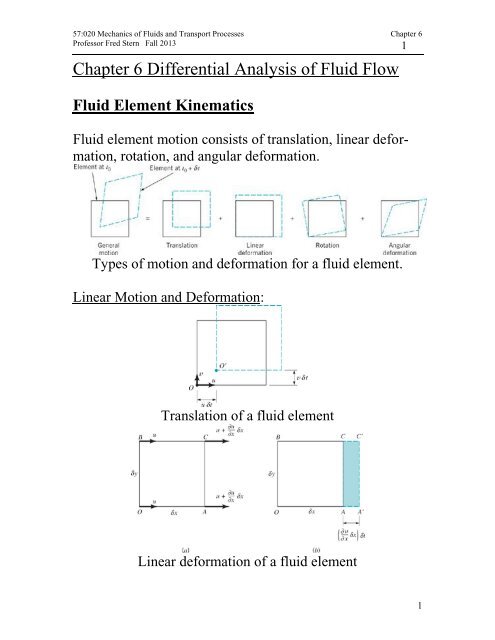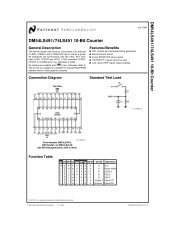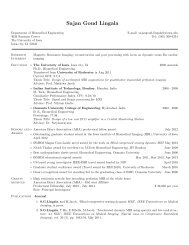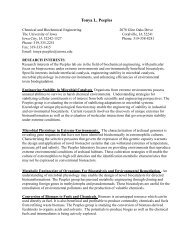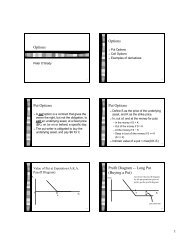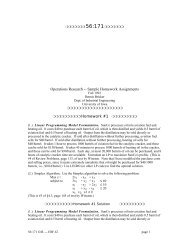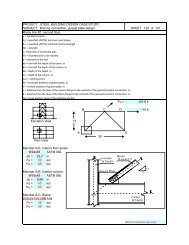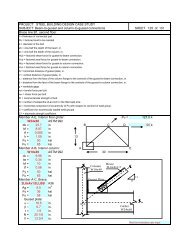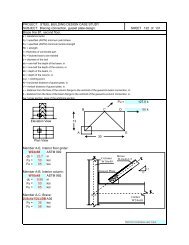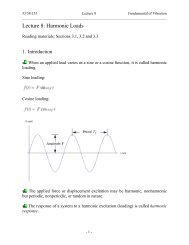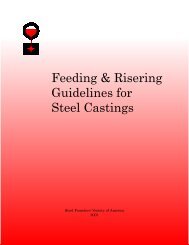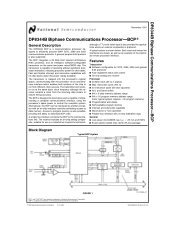Chapter 6
Chapter 6
Chapter 6
You also want an ePaper? Increase the reach of your titles
YUMPU automatically turns print PDFs into web optimized ePapers that Google loves.
57:020 Mechanics of Fluids and Transport Processes <strong>Chapter</strong> 6<br />
Professor Fred Stern Fall 2013<br />
1<br />
<strong>Chapter</strong> 6 Differential Analysis of Fluid Flow<br />
Fluid Element Kinematics<br />
Fluid element motion consists of translation, linear deformation,<br />
rotation, and angular deformation.<br />
Types of motion and deformation for a fluid element.<br />
Linear Motion and Deformation:<br />
Translation of a fluid element<br />
Linear deformation of a fluid element<br />
1
57:020 Mechanics of Fluids and Transport Processes <strong>Chapter</strong> 6<br />
Professor Fred Stern Fall 2013<br />
2<br />
Change in:<br />
<br />
u <br />
x y z <br />
t<br />
x<br />
<br />
the rate at which the volume is changing per unit volume<br />
due to the gradient ∂u/∂x is<br />
1<br />
<br />
<br />
d u x t u<br />
lim<br />
dt t<br />
<br />
0<br />
t x<br />
If velocity gradients ∂v/∂y and ∂w/∂z are also present, then<br />
using a similar analysis it follows that, in the general case,<br />
<br />
<br />
1 d u v w<br />
V<br />
dt x y z<br />
This rate of change of the volume per unit volume is called<br />
the volumetric dilatation rate.<br />
Angular Motion and Deformation<br />
For simplicity we will consider motion in the x–y plane,<br />
but the results can be readily extended to the more general<br />
case.<br />
2
57:020 Mechanics of Fluids and Transport Processes <strong>Chapter</strong> 6<br />
Professor Fred Stern Fall 2013<br />
3<br />
Angular motion and deformation of a fluid element<br />
The angular velocity of line OA, ω OA , is<br />
<br />
OA<br />
lim<br />
t0<br />
t<br />
For small angles<br />
v xxt v tan t<br />
x x<br />
so that<br />
v x<br />
t v<br />
OA<br />
lim <br />
t0<br />
t<br />
x<br />
Note that if ∂v/∂x is positive, ω OA will be counterclockwise.<br />
Similarly, the angular velocity of the line OB is<br />
<br />
OB<br />
u<br />
lim <br />
t0<br />
t<br />
y<br />
In this instance if ∂u/∂y is positive, ω OB will be clockwise.<br />
3
57:020 Mechanics of Fluids and Transport Processes <strong>Chapter</strong> 6<br />
Professor Fred Stern Fall 2013<br />
4<br />
The rotation, ω z , of the element about the z axis is defined<br />
as the average of the angular velocities ω OA and ω OB of the<br />
two mutually perpendicular lines OA and OB. Thus, if<br />
counterclockwise rotation is considered to be positive, it<br />
follows that<br />
1 v<br />
u<br />
z<br />
<br />
2 x<br />
y<br />
Rotation of the field element about the other two coordinate<br />
axes can be obtained in a similar manner:<br />
1 w<br />
v<br />
x<br />
<br />
2 y<br />
z<br />
1 u<br />
w<br />
<br />
y<br />
<br />
2 z<br />
x<br />
<br />
The three components, ω x ,ω y , and ω z can be combined to<br />
give the rotation vector, ω, in the form:<br />
1 1<br />
ω xi yj zk curlV V<br />
2 2<br />
since<br />
i j k<br />
1 1 <br />
V <br />
2 2 x y z<br />
u v w<br />
1 w v 1 u w 1 v u<br />
<br />
i j k<br />
2 y z 2 z x 2 x y<br />
<br />
4
̇<br />
̇<br />
57:020 Mechanics of Fluids and Transport Processes <strong>Chapter</strong> 6<br />
Professor Fred Stern Fall 2013<br />
5<br />
The vorticity, ζ, is defined as a vector that is twice the rotation<br />
vector; that is,<br />
2ω V<br />
The use of the vorticity to describe the rotational characteristics<br />
of the fluid simply eliminates the (1/2) factor associated<br />
with the rotation vector. If V 0 , the flow is<br />
called irrotational.<br />
In addition to the rotation associated with the derivatives<br />
∂u/∂y and ∂v/∂x, these derivatives can cause the fluid element<br />
to undergo an angular deformation, which results in a<br />
change in shape of the element. The change in the original<br />
right angle formed by the lines OA and OB is termed the<br />
shearing strain, δγ,<br />
<br />
The rate of change of δγ is called the rate of shearing strain<br />
or the rate of angular deformation:<br />
̇ [ ( ⁄ ) ( ⁄ ) ]<br />
Similarly,<br />
The rate of angular deformation is related to a corresponding<br />
shearing stress which causes the fluid element to<br />
change in shape.<br />
5
57:020 Mechanics of Fluids and Transport Processes <strong>Chapter</strong> 6<br />
Professor Fred Stern Fall 2013<br />
6<br />
The Continuity Equation in Differential Form<br />
The governing equations can be expressed in both integral<br />
and differential form. Integral form is useful for large-scale<br />
control volume analysis, whereas the differential form is<br />
useful for relatively small-scale point analysis.<br />
Application of RTT to a fixed elemental control volume<br />
yields the differential form of the governing equations. For<br />
example for conservation of mass<br />
V<br />
A<br />
CS<br />
<br />
<br />
CV<br />
<br />
dV<br />
t<br />
net outflow of mass = rate of decrease<br />
across CS<br />
of mass within CV<br />
6
57:020 Mechanics of Fluids and Transport Processes <strong>Chapter</strong> 6<br />
Professor Fred Stern Fall 2013<br />
7<br />
Consider a cubical element oriented so that its sides are to<br />
the (x,y,z) axes<br />
<br />
<br />
u <br />
x<br />
<br />
<br />
outlet mass flux<br />
u<br />
dx<br />
dydz<br />
inlet mass flux<br />
udydz<br />
Taylor series expansion<br />
retaining only first order term<br />
We assume that the element is infinitesimally small such<br />
that we can assume that the flow is approximately one dimensional<br />
through each face.<br />
The mass flux terms occur on all six faces, three inlets, and<br />
three outlets. Consider the mass flux on the x faces<br />
x<br />
<br />
<br />
<br />
ρu ρudx dydz<br />
x<br />
<br />
<br />
ρudydz<br />
<br />
= ( u) dxdydz<br />
x <br />
V<br />
flux outflux influx<br />
Similarly for the y and z faces<br />
<br />
yflux<br />
( v)dxdydz<br />
y<br />
z<br />
flux<br />
<br />
( w)dxdydz<br />
z<br />
7
57:020 Mechanics of Fluids and Transport Processes <strong>Chapter</strong> 6<br />
Professor Fred Stern Fall 2013<br />
8<br />
The total net mass outflux must balance the rate of decrease<br />
of mass within the CV which is<br />
<br />
dxdydz<br />
t<br />
Combining the above expressions yields the desired result<br />
<br />
<br />
( u)<br />
( v)<br />
( w)<br />
dxdydz 0<br />
t x y z<br />
<br />
<br />
dV<br />
<br />
<br />
t<br />
<br />
<br />
( u)<br />
<br />
x<br />
<br />
( v)<br />
<br />
y<br />
<br />
<br />
( w)<br />
z<br />
0<br />
per unit V<br />
differential form of continuity<br />
equations<br />
<br />
(<br />
V)<br />
0<br />
t<br />
<br />
V V<br />
D<br />
V<br />
Dt<br />
0<br />
D<br />
Dt<br />
<br />
<br />
t<br />
V <br />
Nonlinear 1 st order PDE; ( unless = constant, then linear)<br />
Relates V to satisfy kinematic condition of mass conservation<br />
Simplifications:<br />
1. Steady flow: ( V)<br />
0<br />
2. = constant: V 0<br />
8
57:020 Mechanics of Fluids and Transport Processes <strong>Chapter</strong> 6<br />
Professor Fred Stern Fall 2013<br />
9<br />
u<br />
v<br />
w<br />
i.e., 0<br />
x<br />
y<br />
z<br />
3D<br />
u<br />
x<br />
<br />
v<br />
y<br />
0<br />
2D<br />
The continuity equation in Cylindrical Polar Coordinates<br />
The velocity at some arbitrary point P can be expressed as<br />
V vrer ve <br />
vze<br />
z<br />
The continuity equation:<br />
<br />
1rvr 1v<br />
v<br />
<br />
z<br />
0<br />
t r r r <br />
z<br />
For steady, compressible flow<br />
1rvr 1v<br />
vz<br />
0<br />
r r r <br />
z<br />
For incompressible fluids (for steady or unsteady flow)<br />
1rvr<br />
1v<br />
vz<br />
0<br />
r r r <br />
z<br />
9
57:020 Mechanics of Fluids and Transport Processes <strong>Chapter</strong> 6<br />
Professor Fred Stern Fall 2013<br />
10<br />
The Stream Function<br />
Steady, incompressible, plane, two-dimensional flow represents<br />
one of the simplest types of flow of practical importance.<br />
By plane, two-dimensional flow we mean that<br />
there are only two velocity components, such as u and v,<br />
when the flow is considered to be in the x–y plane. For this<br />
flow the continuity equation reduces to<br />
u<br />
v<br />
0<br />
x<br />
y<br />
We still have two variables, u and v, to deal with, but they<br />
must be related in a special way as indicated. This equation<br />
suggests that if we define a function ψ(x, y), called the<br />
stream function, which relates the velocities as<br />
<br />
<br />
u , v <br />
y<br />
x<br />
then the continuity equation is identically satisfied:<br />
2 2<br />
<br />
0<br />
x y y x xy xy<br />
Velocity and velocity components along a streamline<br />
10
57:020 Mechanics of Fluids and Transport Processes <strong>Chapter</strong> 6<br />
Professor Fred Stern Fall 2013<br />
11<br />
Another particular advantage of using the stream function<br />
is related to the fact that lines along which ψ is constant are<br />
streamlines.The change in the value of ψ as we move from<br />
one point (x, y) to a nearby point (x + dx, y + dy) along a<br />
line of constant ψ is given by the relationship:<br />
<br />
d dx dy vdx udy 0<br />
x<br />
y<br />
and, therefore, along a line of constant ψ<br />
dy v<br />
<br />
dx u<br />
The flow between two streamlines<br />
The actual numerical value associated with a particular<br />
streamline is not of particular significance, but the change<br />
in the value of ψ is related to the volume rate of flow. Let<br />
dq represent the volume rate of flow (per unit width perpendicular<br />
to the x–y plane) passing between the two<br />
streamlines.<br />
<br />
<br />
dq udy vdx dx dy d<br />
x<br />
y<br />
Thus, the volume rate of flow, q, between two streamlines<br />
such as ψ1 and ψ2, can be determined by integrating to<br />
yield:<br />
11
57:020 Mechanics of Fluids and Transport Processes <strong>Chapter</strong> 6<br />
Professor Fred Stern Fall 2013<br />
12<br />
q<br />
<br />
<br />
2<br />
d <br />
1<br />
<br />
2 1<br />
In cylindrical coordinates the continuity equation for incompressible,<br />
plane, two-dimensional flow reduces to<br />
1rvr<br />
1v<br />
0<br />
r r r <br />
and the velocity components, v r and v θ , can be related to the<br />
stream function, ψ(r, θ), through the equations<br />
1 <br />
<br />
vr<br />
, v<br />
<br />
r <br />
r<br />
Navier-Stokes Equations<br />
Differential form of momentum equation can be derived by<br />
applying control volume form to elemental control volume<br />
The differential equation of linear momentum: elemental<br />
fluid volume approach<br />
12
57:020 Mechanics of Fluids and Transport Processes <strong>Chapter</strong> 6<br />
Professor Fred Stern Fall 2013<br />
13<br />
⏟<br />
∫<br />
( )<br />
∫<br />
⏟<br />
( )<br />
̂<br />
(1) = ( ) ( )<br />
(2) = [ ( ) ⏟ ( )<br />
⏟<br />
⏟ ( )]<br />
=[ ]<br />
combining and making use of the continuity equation yields<br />
[ { ( )<br />
⏟ } ( )]<br />
or<br />
where<br />
13
57:020 Mechanics of Fluids and Transport Processes <strong>Chapter</strong> 6<br />
Professor Fred Stern Fall 2013<br />
14<br />
Body forces are due to external fields such as gravity or<br />
magnetics. Here we only consider a gravitational field; that<br />
is,<br />
F<br />
and<br />
i.e.,<br />
dFgrav<br />
gdxdydz<br />
g gkˆ<br />
for g z<br />
f body gkˆ<br />
body<br />
Surface forces are due to the stresses that act on the sides of<br />
the control surfaces<br />
symmetric ( ij = ji )<br />
ij = - p ij + ij<br />
2 nd order tensor<br />
normal pressure<br />
viscous stress<br />
ij = 1<br />
ij = 0<br />
i = j<br />
i j<br />
= -p+ xx xy xz<br />
yx -p+ yy yz<br />
zx zy -p+ zz<br />
As shown before for p alone it is not the stresses themselves<br />
that cause a net force but their gradients.<br />
<br />
<br />
x<br />
<br />
y<br />
<br />
z<br />
dF x,surf = <br />
<br />
<br />
<br />
<br />
dxdydz<br />
<br />
<br />
<br />
p<br />
x<br />
xx<br />
<br />
x<br />
xy<br />
<br />
y<br />
= <br />
<br />
<br />
<br />
<br />
dxdydz<br />
xx<br />
xy<br />
xz<br />
<br />
<br />
<br />
z<br />
xz<br />
<br />
<br />
14
57:020 Mechanics of Fluids and Transport Processes <strong>Chapter</strong> 6<br />
Professor Fred Stern Fall 2013<br />
15<br />
This can be put in a more compact form by defining vector<br />
stress on x-face<br />
<br />
x<br />
<br />
xx<br />
î <br />
xy<br />
ĵ<br />
<br />
xz<br />
kˆ<br />
and noting that<br />
p<br />
<br />
dF x,surf =<br />
<br />
x dxdydz<br />
x<br />
<br />
p<br />
f x,surf = x<br />
per unit volume<br />
x<br />
similarly for y and z<br />
p<br />
f y,surf = y<br />
y yxî<br />
yyĵ<br />
yzkˆ<br />
y<br />
f z,surf =<br />
p<br />
z<br />
z zxî<br />
zyĵ<br />
zzkˆ<br />
z<br />
finally if we define<br />
î ĵ<br />
kˆ then<br />
ij<br />
x<br />
y<br />
z<br />
f<br />
surf<br />
p<br />
ij<br />
ij<br />
ij pij<br />
ij<br />
15
57:020 Mechanics of Fluids and Transport Processes <strong>Chapter</strong> 6<br />
Professor Fred Stern Fall 2013<br />
16<br />
Putting together the above results<br />
f<br />
f<br />
body<br />
f<br />
surf<br />
<br />
DV<br />
Dt<br />
f body gkˆ<br />
f p<br />
<br />
surface<br />
DV V<br />
a VV<br />
Dt t<br />
ij<br />
a gkˆ<br />
p<br />
<br />
ij<br />
inertia body<br />
force force surface surface force<br />
due to force due due to viscous<br />
gravity to p shear and normal<br />
stresses<br />
16
57:020 Mechanics of Fluids and Transport Processes <strong>Chapter</strong> 6<br />
Professor Fred Stern Fall 2013<br />
17<br />
For Newtonian fluid the shear stress is proportional to the<br />
rate of strain, which for incompressible flow can be written<br />
( )<br />
where,<br />
= coefficient of viscosity<br />
= rate of strain tensor<br />
( ) ( )<br />
=<br />
( ) ( )<br />
[<br />
( ) ( )<br />
]<br />
Ex) 1-D flow<br />
̂ ( )<br />
where,<br />
( ) ( )<br />
⏟ ⏟<br />
(<br />
)<br />
̂<br />
( ) Navier-Stokes Equation<br />
Continuity Equation<br />
17
57:020 Mechanics of Fluids and Transport Processes <strong>Chapter</strong> 6<br />
Professor Fred Stern Fall 2013<br />
18<br />
Four equations in four unknowns: V and p<br />
Difficult to solve since 2 nd order nonlinear PDE<br />
x: [ ] [ ]<br />
y: [ ] [ ]<br />
z: [ ] [ ]<br />
u<br />
x<br />
v<br />
<br />
y<br />
w<br />
<br />
z<br />
0<br />
Navier-Stokes equations can also be written in other coordinate<br />
systems such as cylindrical, spherical, etc.<br />
There are about 80 exact solutions for simple geometries.<br />
For practical geometries, the equations are reduced to algebraic<br />
form using finite differences and solved using computers.<br />
18
57:020 Mechanics of Fluids and Transport Processes <strong>Chapter</strong> 6<br />
Professor Fred Stern Fall 2013<br />
19<br />
Ex) Exact solution for laminar incompressible steady flow<br />
in a circular pipe<br />
Use cylindrical coordinates with assumptions<br />
: Fully-developed flow<br />
: Flow is parallel to the wall<br />
Continuity equation:<br />
( )<br />
i.e.,<br />
B.C. ( ) <br />
19
57:020 Mechanics of Fluids and Transport Processes <strong>Chapter</strong> 6<br />
Professor Fred Stern Fall 2013<br />
20<br />
Momentum equation:<br />
( )<br />
[ ( ) ]<br />
( )<br />
[ ( ) ]<br />
( )<br />
[ ( ) ]<br />
or<br />
(1)<br />
(2)<br />
[ ( )] (3)<br />
where,<br />
Equations (1) and (2) can be integrated to give<br />
( ) ( ) ( )<br />
pressure is hydrostatic and ⁄ is not a function<br />
of or<br />
20
57:020 Mechanics of Fluids and Transport Processes <strong>Chapter</strong> 6<br />
Professor Fred Stern Fall 2013<br />
21<br />
Equation (3) can be written in the from<br />
( )<br />
and integrated (using the fact that ⁄ = constant) to<br />
give<br />
( )<br />
Integrating again we obtain<br />
( )<br />
B.C.<br />
( ) <br />
( ) ( )<br />
( ) ( )<br />
at any cross section the velocity distribution is parabolic<br />
21
57:020 Mechanics of Fluids and Transport Processes <strong>Chapter</strong> 6<br />
Professor Fred Stern Fall 2013<br />
22<br />
1) Flow rate :<br />
∫ ∫ ( )<br />
where, ( )<br />
If the pressure drops over a length :<br />
2) Mean velocity :<br />
( ) ( )<br />
3) Maximum velocity :<br />
( ) ( )<br />
<br />
( )<br />
22
57:020 Mechanics of Fluids and Transport Processes <strong>Chapter</strong> 6<br />
Professor Fred Stern Fall 2013<br />
23<br />
4) Wall shear stress ( ) :<br />
( )<br />
where<br />
⏟ ( )<br />
Thus, at the wall (i.e., ),<br />
( )<br />
and with ,<br />
|( ) |<br />
Note: Only valid for laminar flows. In general, the flow<br />
remains laminar for Reynolds numbers, Re = ( ) ⁄ ,<br />
below 2100. Turbulent flow in tubes is considered in <strong>Chapter</strong><br />
8.<br />
23
57:020 Mechanics of Fluids and Transport Processes <strong>Chapter</strong> 6<br />
Professor Fred Stern Fall 2013<br />
24<br />
Differential Analysis of Fluid Flow<br />
We now discuss a couple of exact solutions to the Navier-<br />
Stokes equations. Although all known exact solutions<br />
(about 80) are for highly simplified geometries and flow<br />
conditions, they are very valuable as an aid to our understanding<br />
of the character of the NS equations and their solutions.<br />
Actually the examples to be discussed are for internal<br />
flow (<strong>Chapter</strong> 8) and open channel flow (<strong>Chapter</strong><br />
10), but they serve to underscore and display viscous flow.<br />
Finally, the derivations to follow utilize differential analysis.<br />
See the text for derivations using CV analysis.<br />
Couette Flow<br />
boundary conditions<br />
First, consider flow due to the relative motion of two parallel<br />
plates<br />
u Continuity 0<br />
x<br />
d u<br />
Momentum 0 <br />
2<br />
dy<br />
2<br />
u = u(y)<br />
v = o<br />
p<br />
p<br />
<br />
x<br />
y<br />
0<br />
or by CV continuity and momentum equations:<br />
24
57:020 Mechanics of Fluids and Transport Processes <strong>Chapter</strong> 6<br />
Professor Fred Stern Fall 2013<br />
25<br />
u y<br />
u<br />
2<br />
u 1 = u 2<br />
1 <br />
y<br />
<br />
Fx<br />
uV<br />
dA<br />
Q u2<br />
u1<br />
0<br />
dp d<br />
<br />
py<br />
p<br />
xy<br />
x<br />
dyx<br />
= 0<br />
dx dy <br />
d<br />
0<br />
dy<br />
d du <br />
i.e. 0<br />
dy dy <br />
2<br />
d u<br />
0<br />
2<br />
dy<br />
from momentum equation<br />
<br />
du C<br />
dy<br />
C<br />
u y <br />
<br />
D<br />
u(0) = 0 D = 0<br />
U<br />
u y<br />
t<br />
du<br />
<br />
dy<br />
u(t) = U C =<br />
U<br />
<br />
t<br />
U<br />
<br />
t<br />
constant<br />
25
57:020 Mechanics of Fluids and Transport Processes <strong>Chapter</strong> 6<br />
Professor Fred Stern Fall 2013<br />
26<br />
Generalization for inclined flow with a constant pressure<br />
gradient<br />
u Continutity 0<br />
x<br />
d u<br />
0 p z<br />
<br />
x<br />
dy<br />
Momentum <br />
2<br />
2<br />
u = u(y)<br />
v = o<br />
p<br />
0<br />
y<br />
i.e.,<br />
2<br />
d u dh<br />
h = p/ +z = constant<br />
2<br />
dy dx<br />
which can be integrated twice to yield<br />
<br />
du<br />
dy<br />
u <br />
<br />
dh<br />
dx<br />
dh<br />
dx<br />
y<br />
2<br />
y A<br />
2<br />
Ay B<br />
dz<br />
plates horizontal 0<br />
dx<br />
dz<br />
plates vertical =-1 dx<br />
26
57:020 Mechanics of Fluids and Transport Processes <strong>Chapter</strong> 6<br />
Professor Fred Stern Fall 2013<br />
27<br />
now apply boundary conditions to determine A and B<br />
u(y = 0) = 0 B = 0<br />
u(y = t) = U<br />
U<br />
<br />
dh<br />
dx<br />
2<br />
t<br />
2<br />
At<br />
A<br />
<br />
U<br />
t<br />
<br />
dh<br />
dx<br />
t<br />
2<br />
dh y<br />
u(y) <br />
dx 2<br />
dh<br />
<br />
2<br />
dx<br />
2<br />
1 U<br />
<br />
<br />
<br />
t<br />
U<br />
ty y<br />
2 <br />
t<br />
dh<br />
dx<br />
= y<br />
This equation can be put in non-dimensional form:<br />
2<br />
u t<br />
dh y y y<br />
1<br />
<br />
U 2U<br />
dx t t t<br />
t<br />
2<br />
<br />
<br />
<br />
define: P = non-dimensional pressure gradient<br />
t 2 dh<br />
p<br />
= h z<br />
2U<br />
dx<br />
<br />
Y = y/t<br />
u<br />
PY(1<br />
Y) Y<br />
U<br />
parabolic velocity profile<br />
1 dp<br />
<br />
2U<br />
<br />
<br />
dx<br />
z 2<br />
<br />
dz<br />
dx<br />
<br />
<br />
27
57:020 Mechanics of Fluids and Transport Processes <strong>Chapter</strong> 6<br />
Professor Fred Stern Fall 2013<br />
28<br />
u<br />
U<br />
<br />
2<br />
Py Py<br />
<br />
2<br />
t t<br />
<br />
y<br />
t<br />
q<br />
u<br />
t<br />
udy<br />
<br />
0<br />
q<br />
t<br />
t<br />
<br />
U<br />
0<br />
<br />
t<br />
<br />
dy<br />
tu<br />
U<br />
t 0<br />
P<br />
<br />
y <br />
t<br />
P 2 y<br />
y <br />
2 <br />
dy<br />
t t <br />
=<br />
Pt<br />
2<br />
<br />
Pt<br />
3<br />
<br />
t<br />
2<br />
u<br />
U<br />
<br />
P<br />
6<br />
<br />
1<br />
2<br />
u<br />
2<br />
t <br />
<br />
12<br />
<br />
dh <br />
<br />
dx <br />
U<br />
2<br />
ut<br />
For laminar flow 1000<br />
<br />
Re crit 1000<br />
28
57:020 Mechanics of Fluids and Transport Processes <strong>Chapter</strong> 6<br />
Professor Fred Stern Fall 2013<br />
29<br />
The maximum velocity occurs at the value of y for which:<br />
du d u P 2P 1<br />
0 0 y <br />
2<br />
dy dy U t t t<br />
t t t<br />
y P<br />
1<br />
@ u max<br />
2P 2 2P<br />
for U = 0, y = t/2<br />
<br />
u<br />
max<br />
u<br />
<br />
y<br />
max<br />
<br />
<br />
UP<br />
4<br />
<br />
U<br />
2<br />
<br />
U<br />
4P<br />
note: if U = 0:<br />
u<br />
u<br />
max<br />
<br />
P<br />
6<br />
P<br />
4<br />
<br />
2<br />
3<br />
The shape of the velocity profile u(y) depends on P:<br />
dh<br />
1. If P > 0, i.e., 0 the pressure decreases in the<br />
dx<br />
direction of flow (favorable pressure gradient) and the<br />
velocity is positive over the entire width<br />
<br />
dh<br />
dx<br />
<br />
d<br />
dx<br />
<br />
<br />
<br />
p<br />
<br />
<br />
z<br />
<br />
<br />
dp<br />
dx<br />
sin<br />
<br />
dp<br />
a) 0<br />
dx<br />
dp<br />
b) sin<br />
<br />
dx<br />
29
57:020 Mechanics of Fluids and Transport Processes <strong>Chapter</strong> 6<br />
Professor Fred Stern Fall 2013<br />
30<br />
1. If P < 0, i.e., dh dx 0 the pressure increases in the direction<br />
of flow (adverse pressure gradient) and the velocity<br />
over a portion of the width can become negative<br />
(backflow) near the stationary wall. In this case the<br />
dragging action of the faster layers exerted on the fluid<br />
particles near the stationary wall is insufficient to overcome<br />
the influence of the adverse pressure gradient.<br />
dp<br />
dx<br />
dp<br />
sin<br />
0<br />
sin<br />
<br />
dx<br />
or<br />
sin <br />
dp<br />
dx<br />
dh<br />
2. If P = 0, i.e., 0 the velocity profile is linear<br />
dx<br />
U<br />
u y<br />
t<br />
dp<br />
a) 0 and = 0 Note: we derived<br />
dx<br />
this special case<br />
dp<br />
b) sin<br />
<br />
dx<br />
u<br />
For U = 0 the form PY1<br />
Y<br />
Y is not appropriate<br />
U<br />
u = UPY(1-Y)+UY<br />
t 2 dh<br />
= Y1<br />
Y<br />
UY<br />
2<br />
dx<br />
t<br />
2<br />
dh<br />
dx<br />
Now let U = 0: u Y1<br />
Y<br />
2<br />
30
57:020 Mechanics of Fluids and Transport Processes <strong>Chapter</strong> 6<br />
Professor Fred Stern Fall 2013<br />
31<br />
3. Shear stress distribution<br />
Non-dimensional velocity distribution<br />
where<br />
u<br />
U<br />
2<br />
t dh<br />
P <br />
2U dx<br />
y<br />
Y <br />
t<br />
* u<br />
Shear stress<br />
u<br />
U<br />
*<br />
u PY 1Y Y<br />
is the non-dimensional velocity,<br />
<br />
<br />
is the non-dimensional pressure gradient<br />
is the non-dimensional coordinate.<br />
du<br />
<br />
dy<br />
In order to see the effect of pressure gradient on shear<br />
stress using the non-dimensional velocity distribution, we<br />
define the non-dimensional shear stress:<br />
Then<br />
where<br />
*<br />
<br />
*<br />
<br />
<br />
1<br />
<br />
2 U<br />
2<br />
<br />
<br />
<br />
<br />
1 Ud u U 2<br />
du<br />
<br />
1 2<br />
U<br />
td y t Ut dY<br />
2<br />
2<br />
2PY<br />
P 1<br />
Ut<br />
2<br />
2PY<br />
P 1<br />
Ut<br />
<br />
A 2PY P 1<br />
2<br />
A 0 is a positive constant.<br />
Ut<br />
So the shear stress always varies linearly with Y across any<br />
section.<br />
<br />
*<br />
31
57:020 Mechanics of Fluids and Transport Processes <strong>Chapter</strong> 6<br />
Professor Fred Stern Fall 2013<br />
32<br />
At the lower wall Y 0<br />
:<br />
At the upper wall <br />
<br />
*<br />
1<br />
lw<br />
A P<br />
1<br />
<br />
*<br />
1<br />
<br />
Y :<br />
uw<br />
A P<br />
For favorable pressure gradient, the lower wall shear stress<br />
is always positive:<br />
1. For small favorable pressure gradient 0P<br />
1<br />
:<br />
*<br />
0 and 0<br />
*<br />
lw<br />
2. For large favorable pressure gradient 1<br />
*<br />
lw<br />
uw<br />
0 and 0<br />
*<br />
uw<br />
P :<br />
<br />
<br />
<br />
P<br />
<br />
P 1<br />
0 1<br />
For adverse pressure gradient, the upper wall shear stress is<br />
always positive:<br />
1. For small adverse pressure gradient 1 P 0:<br />
*<br />
0 and 0<br />
*<br />
lw<br />
2. For large adverse pressure gradient 1<br />
*<br />
lw<br />
uw<br />
*<br />
0 and 0<br />
uw<br />
P :<br />
32
57:020 Mechanics of Fluids and Transport Processes <strong>Chapter</strong> 6<br />
Professor Fred Stern Fall 2013<br />
33<br />
<br />
<br />
1 P 0<br />
P 1<br />
For U 0 , i.e., channel flow, the above non-dimensional<br />
form of velocity profile is not appropriate. Let’s use dimensional<br />
form:<br />
2<br />
t dh<br />
dh<br />
u <br />
<br />
Y Y y t y<br />
2<br />
dx<br />
2<br />
dx<br />
<br />
1<br />
<br />
Thus the fluid always flows in the direction of decreasing<br />
piezometric pressure or piezometric head because<br />
<br />
0, y 0<br />
2 and ty 0 . So if dh<br />
dx is negative, u is positive;<br />
if dh<br />
dx is positive, u is negative.<br />
Shear stress:<br />
du dh 1 <br />
t y <br />
dy 2 dx 2 <br />
Since<br />
1 <br />
t<br />
y0<br />
2 <br />
, the sign of shear stress is always opposite<br />
to the sign of piezometric pressure gradient dh<br />
, and the<br />
magnitude of is always maximum at both walls and zero<br />
at centerline of the channel.<br />
dx<br />
33
57:020 Mechanics of Fluids and Transport Processes <strong>Chapter</strong> 6<br />
Professor Fred Stern Fall 2013<br />
34<br />
dh<br />
For favorable pressure gradient, 0<br />
dx , 0<br />
For adverse pressure gradient, 0<br />
dx , 0<br />
dh<br />
Flow down an inclined plane<br />
dh<br />
0<br />
dx dh<br />
0<br />
dx <br />
uniform flow velocity and depth do not<br />
change in x-direction<br />
Continuity 0<br />
dx<br />
<br />
du <br />
<br />
34
57:020 Mechanics of Fluids and Transport Processes <strong>Chapter</strong> 6<br />
Professor Fred Stern Fall 2013<br />
35<br />
d u<br />
x-momentum 0 p<br />
z<br />
<br />
2<br />
x<br />
dy<br />
<br />
y-momentum p<br />
z<br />
y<br />
dp 0<br />
dx<br />
0 hydrostatic pressure variation<br />
2<br />
2<br />
d u<br />
<br />
2<br />
dy<br />
sin<br />
<br />
du<br />
dy<br />
<br />
<br />
<br />
sin y<br />
c<br />
u<br />
2<br />
y<br />
sin <br />
2<br />
Cy D<br />
du<br />
dy<br />
yd<br />
0<br />
<br />
<br />
<br />
sin d<br />
c c<br />
<br />
<br />
<br />
sin d<br />
u(0) = 0 D = 0<br />
u<br />
2<br />
y<br />
sin <br />
2<br />
<br />
<br />
sin dy<br />
<br />
<br />
2<br />
= sin y2d<br />
y<br />
35
57:020 Mechanics of Fluids and Transport Processes <strong>Chapter</strong> 6<br />
Professor Fred Stern Fall 2013<br />
36<br />
gsin <br />
2<br />
u(y) = y2d<br />
y<br />
q<br />
<br />
d<br />
3<br />
<br />
2 y<br />
udy sin dy<br />
<br />
0 2<br />
3<br />
= 1 <br />
d<br />
3 sin <br />
3 <br />
<br />
<br />
<br />
<br />
<br />
d<br />
0<br />
discharge per<br />
unit width<br />
V<br />
avg<br />
<br />
q<br />
d<br />
<br />
1<br />
3<br />
<br />
<br />
d<br />
2<br />
sin <br />
2<br />
gd<br />
3<br />
sin <br />
in terms of the slope S o = tan sin <br />
V<br />
<br />
2<br />
gd S<br />
3 <br />
o<br />
Exp. show Re crit 500, i.e., for Re > 500 the flow will become<br />
turbulent<br />
p<br />
y<br />
cos<br />
Re <br />
Vd<br />
crit 500<br />
<br />
p cos<br />
y C<br />
d<br />
p po cosd<br />
C<br />
36
57:020 Mechanics of Fluids and Transport Processes <strong>Chapter</strong> 6<br />
Professor Fred Stern Fall 2013<br />
37<br />
p cos<br />
d y<br />
p<br />
i.e., o<br />
* p(d) > p o<br />
* if = 0 p = (d y) + p o<br />
entire weight of fluid imposed<br />
if = /2<br />
p = p o<br />
no pressure change through the fluid<br />
37


